WORD NEWS
Mariupol: The damage of a metropolis | Ukraine
For greater than 80 days, the Russians bombarded Mariupol, decided to take the port metropolis even when they needed to raze it to the bottom first.

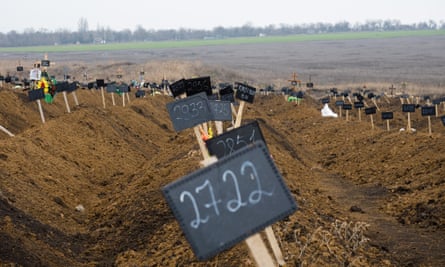
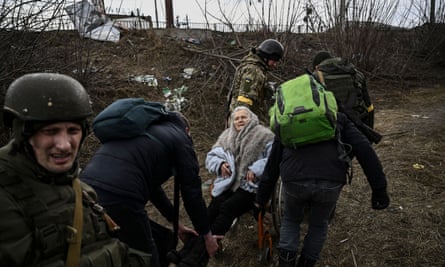
After Russian forces lastly crushed Ukrainian resistance final Might, they set about placing their stamp on Mariupol, erasing proof of the latest atrocities and of previous Ukrainian historical past within the metropolis.
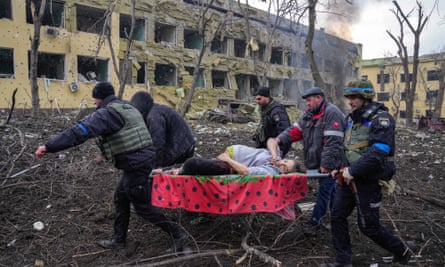
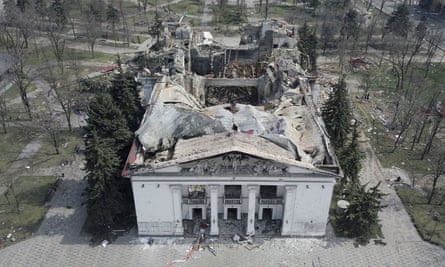
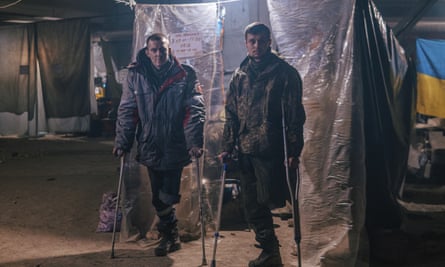
A yr on from the invasion of Ukraine, the Guardian tells the story of Mariupol – maybe the bloodiest and most stunning chapter of Russia’s brutal warfare.
Invasion
Mariupol greets the brand new yr, 2022, in a relaxed temper. When a robust gust of wind blows over the town Christmas tree, sending its huge illuminated branches crashing to the bottom, a number of suspicious varieties whisper that it may very well be a nasty omen for the yr forward.
However most individuals pay little heed to the crescendo of chatter about Vladimir Putin’s nefarious plans for Ukraine.
They’re used to the thought of warfare right here, after the occasions of 2014 when Russian proxies seized neighbouring Donetsk and briefly managed Mariupol, too. The frontline, simply exterior the town, has hardly moved for years. Occasional navy skirmishes are a truth of life, however the thought of a full-scale invasion appears fanciful.
So for the primary seven weeks of the yr, life goes on kind of as regular. Folks huddle in cafes smoking shisha on chilly evenings; youngsters giggle as they slip on the ice rink behind the drama theatre. At a close-by restaurant one Saturday evening, a bunch of ladies dance to a vocalist singing in Russian and English; their husbands stay seated, nursing beers.
Just a few individuals do turn into uneasy and clear out their basements, equipping them as bomb shelters. They refill on tinned meals. Usually, their buddies tease them for such eccentric behaviour.
After which, within the early hours of 24 February, it begins.
Round 5am, calls exit to the chiefs of police and different municipal companies, asserting that navy hostilities have begun and ordering them into their places of work. Most of them are already awake, roused by the sound of Russian artillery.
At 11 within the morning, the mayor, Vadym Boychenko, convenes a press convention. Already, three civilians are useless and 6 injured, he says. The temper within the room is tense, however Boychenko assures the few journalists current that officers and key infrastructure employees are nonetheless working, and life will keep it up.
“Don’t panic. We’re able to battle for Mariupol and Ukraine,” says the mayor.
He and most of his workforce will flee the town three days later.

On these first few days, the preventing is proscribed to the outskirts of the town. Wounded troopers arrive on the hospitals from the entrance, and a whole lot of volunteers present as much as donate blood.
There are lengthy queues at ATMs and petrol stations, however public transport continues to be working, and a few individuals stoically proceed as if every part is regular, heading for work.
On the prepare station, a younger couple hurries alongside the platform dragging suitcases and cradling a cat. Tearful mother and father bundle their youngsters on to evacuation trains heading for Kyiv. However the trains go away half empty. By the point most individuals realise what’s coming, it is going to be too late to go away.
Town is effectively defended from the east, the place everybody anticipated the Russians to launch an assault. However there was no preparation for an invasion from the west. Russian troops pour throughout the slim isthmus from Crimea in the direction of Mariupol, and inside a number of days, the town is encircled.
Nearly instantly, the Russians hit the electrical energy, water and fuel provides. Folks soften snow for water, and cook dinner exterior over open flames. Cellphone reception disappears, creating an data vacuum. The final outlets shut their doorways, quickly to be looted by individuals determined for meals.
Because the preventing turns into extra intense, individuals drag mattresses into the stairwells of their residence blocks, or transfer into their darkish and freezing basements. Some individuals are too previous or too frail to maneuver. Most of them won’t survive.
At Hospital Quantity One, on the jap facet of the town, Serhiy Mudryi, a traumatologist, arrives for a two-day shift on 28 February. It’s too harmful to maneuver across the metropolis, so Mudryi sleeps on the hospital. His shift will find yourself lasting 40 days; he leaves solely as soon as, to gather his household and produce them again to the hospital, giving them beds in an empty ward.
Many of the different docs flee, and shortly there may be only a skeleton workforce remaining on the hospital: Mudryi, two surgeons, an anaesthesiologist and a few nurses.
Arrivals are frequent, each troopers and civilians. Earlier than lengthy, the ambulances cease working and sufferers arrive in personal vehicles, pushed by family frantic with fear. It takes loads to shock a traumatologist with twenty years of expertise, however the minced flesh and crushed our bodies Mudryi is seeing on daily basis flip his abdomen.
The docs wouldn’t have the time for the difficult operations required to save lots of limbs. “Submit-operation, wounds require a lot of care, there’s a big danger of an infection and gangrene, after which dying from it,” Mudryi explains to sufferers. Now, every time there’s a critical harm, the docs amputate. The affected person will lose an arm or a leg however have extra likelihood of staying alive.
Because the preventing shifts into the suburbs and extra buildings come beneath hearth, many individuals who dwell near the hospital arrive and transfer into the hospital basements. One 92-year-old lady tells Mudryi she has come as a result of she remembers hiding in the identical place in the course of the second world warfare.
The hope that hospitals can be spared the worst of the warfare seems to be naive. Throughout city, a maternity ward is shelled, and images of a bloodied, closely pregnant lady scrambling via the rubble shock the world. Russian officers counsel the lady is an actor.
Quickly after, within the Turkish resort city of Antalya, the Russian and Ukrainian international ministers meet, the highest-level dialogue for the reason that warfare began. The 2 males talk about Mariupol greater than anything.
Russia’s Sergei Lavrov appears to be like his Ukrainian counterpart Dmytro Kuleba within the eye, and tells him the maternity ward was stuffed with Ukrainian fighters, not pregnant girls.
“Sadly, I can affirm that the Russian management, together with minister Lavrov, dwell in their very own actuality,” says Kuleba.
The talks break up after 90 minutes, with no settlement on something.

Siege
With no cellular reception within the metropolis, rumours unfold of ceasefires and of evacuation corridors, however there is no such thing as a verified data. Will the Ukrainian forces allow them to out? Will the Russians shoot at them on the way in which? Are Russian troops already in Kyiv? No one is aware of for positive.
The preventing intensifies to a degree the place dashing to a effectively or stream for a bucket of water carries a critical danger of being a one-way mission. Throughout breaks within the shelling, individuals dig shallow graves and bury the useless on the spot.
In a single central residence block, a bunch of males sprint out in mid-March to bury a number of older girls, killed whereas cooking over an open hearth in a courtyard. It’s a scene repeated throughout the town.
“I knew these previous girls all my life. They sat exterior the residence block on the benches, chatting away, passing the time. After which it’s important to shut the eyes of these girls and bury them in their very own courtyard,” remembers Vitaly, one of many impromptu gravediggers.
Elsewhere in Ukraine, individuals desperately attempt to contact family in Mariupol to seek out out if they’re nonetheless alive. “This telephone quantity is out of protection,” is invariably the automated response. Folks start to have nightmares in regards to the phrase.
Each few days, there could be a fleeting second when a bar of reception seems and folks’s telephones mild up with messages. Generally, the delayed information brings a wave of overwhelming aid at an indication of life, on different events it brings affirmation of the worst fears.
As time goes by, some individuals turn into offended and hysterical, because it dawns on them that there is no such thing as a protected means out of the town and so they could die of their basements, from the chilly, the starvation or the bombs.
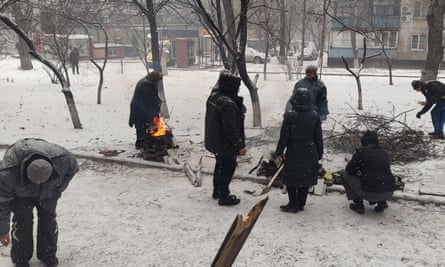
Maryna Puhachova, an activist and lawyer, develops a morning ritual to assist her keep calm: quickly after daybreak, she goes exterior with the neighbours, collects some snow and boils it over a flame to make espresso.
A bit later, she sits by the window, the one supply of sunshine in her residence, and applies her make-up. The booms are relentless, and subsequent to the window is probably the most harmful place to be, however she finds the routine to be soothing.
Some individuals within the neighbouring block see her doing it and suspect she could have gone mad. However then they begin doing it too, and earlier than lengthy a morning ritual is established through which a number of girls sit at their home windows, wave to one another and do their make-up. It’s a small second of humanity that retains them going.
Through the days, when the shelling quietens, Puhachova speeds throughout city to a distribution level, the place volunteers accumulate meals assist and drive it to locations the place they know there are massive concentrations of individuals sheltering in cellars.
Puhachova has labored for a few years within the villages round Mariupol, for an organisation providing authorized and psychological assist to individuals residing near the entrance line. She is used to working beneath stress. However with every day, the runs throughout city get hairier. She sees burning vehicles, and corpses gnawed at by stray canines.
She witnesses acts of grim selfishness, corresponding to individuals attempting to promote looted provides for a revenue, but additionally gestures of outstanding bravery and kindness, like those that give away their final meals and medicines to individuals in higher want.
She tries her hardest to placed on a courageous face when she visits the basements to ship meals and sees the desperation in individuals’s faces. She will be able to sense that individuals seem reassured by the sight of somebody who stays sturdy and cheerful, at the least on the surface.
Theatre strike
As extra residential blocks maintain hits, and with evacuation routes out of the town closed off, many individuals congregate at a sequence of public shelters. Maybe the biggest is on the drama theatre, the place greater than 1,000 individuals take refuge. In entrance of the colonnaded constructing, somebody spells out the phrase DETI – youngsters – in big Russian letters.
On 11 March, Oleksandr Khodzhava, a steelworker, arrives on the theatre along with his mother and father, spouse and two younger daughters. Heavy shelling close to their residence block has collapsed the plaster ceiling of their basement, and the neighbours point out that the drama theatre has turn into a refugee shelter, and thus must be spared from strikes.
On arrival, the household discover a place to sleep on the chilly ground of a fancy dress room, beside stitching machines and bits of fabric. They obtain meagre rations thrice per day: scorching water for breakfast, soup for lunch, and a biscuit for dinner.
Early within the morning on 16 March, they relocate to the cellar, a theatre management room stuffed with electronics, considering it is going to be safer there. The ground is roofed with smooth padding ripped from seats and armchairs.
Oleksandr goes to assist with meals preparations, whereas his spouse takes their youngest daughter again as much as the costume room, to scrub their former quarters. Oleksandr’s mother and father, Serhiy and Iryna, keep down within the basement.
Someplace within the distance, they hear the faint noise of a airplane’s engines. Shortly after, there’s a flash and an enormous explosion.
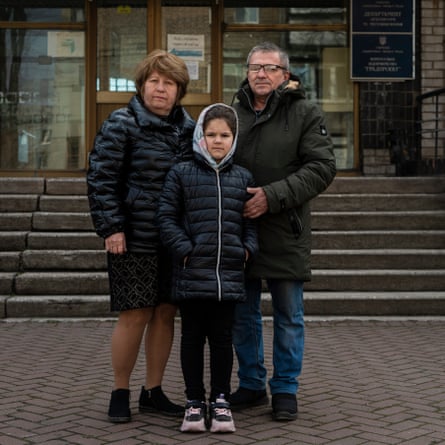
The blast throws Serhiy 3 metres throughout the room and rips off the cellar doorways. Every part is roofed in chalky mud; thick smoke hangs within the air. He struggles to his ft after releasing himself and clambers his means out of the cellar. The ground is awash with blood, and thru the smoke he sees two males pull one other man from the rubble, his boots hooked up to his legs solely by bloodied pores and skin, all of the bone gone.
Within the touchdown space by the steps, Serhiy finds his spouse and their eldest granddaughter, however Oleksandr has been crushed beneath rubble. Oleksandr’s spouse, Anastasia, and their younger daughter, Karolina, are additionally lacking within the costume room. Though dazed and shocked, trying on the ruins Serhiy is aware of for positive there is no such thing as a likelihood any of the three survived.
Serhiy and his spouse, holding their surviving granddaughter, Valeriya, by the hand, wander in shock within the streets across the theatre, coughing from the mud and uncertain what to do.
After a while, a household in a automotive about to embark on the dangerous journey out of Mariupol hears the wails of the newly orphaned Valeriya, and gives the trio a elevate. They make it to Ukrainian-controlled territory, the place they need to begin a brand new life outfitted with no possessions to talk of and a devastating sense of loss.
Russia first claims the theatre was stuffed with Ukrainian troops. Later, it modifications its story, insisting the theatre was blown up by Ukrainian forces as a “provocation”. The proof, nonetheless, factors to a Russian airstrike.
The Related Press estimates that 600 individuals died within the assault.

Collapse
The final vestiges of Ukrainian authority in Mariupol fade quickly. On 15 March a choice is made that policing is now not attainable. Round half of the prewar police pressure continues to be within the metropolis, lots of them sleeping on the ground in barricaded police stations and heading out on patrol after they can. Now, they’ve a choice to make.
Some be a part of the military, others try to go away the town on routes dotted with quite a few checkpoints, the place Russian troopers are looking out for anybody pro-Ukrainian. Quickly, the Russians will arrange “filtration” centres to query anybody leaving Mariupol, involving strip searches and prolonged questioning, however for now, the method continues to be advert hoc.
At one checkpoint, Artem Kisko, the deputy head of the regional police, tells a speedily invented story that he’s a espresso salesman who has misplaced his paperwork. The troopers rapidly tire of the lengthy yarn about espresso provides. They let him via.
One other Mariupol police officer is recognised at a checkpoint by a former colleague from Donetsk, who in 2014 took the facet of the Russians and now serves within the military of the so-called Donetsk Folks’s Republic.
The soldier recognises his previous colleague instantly, and initially points threats. However then, simply as he’s turning to inform his superiors he has caught a Ukrainian cop, one thing modifications in his eyes. “Go,” he whispers, and waves the automotive via the checkpoint. The police officer drives on, shaken, and reaches Ukrainian-held territory safely.
Lives and fates activate such split-second moments. On many different events, Ukrainian police, officers or activists are recognized and hauled off to Russian basements for interrogation or worse.
The Worldwide Committee of the Pink Cross pushes Kyiv and Moscow to create a humanitarian hall to let civilians out of Mariupol in a protected and orderly means, however there is no such thing as a settlement.
Many individuals attempt to run the gauntlet anyway, driving throughout the frontlines and braving the a number of Russian checkpoints. There isn’t a petrol left within the metropolis now, so seats in autos with sufficient juice to make the journey are bartered and pleaded over. In Zaporizhzhia, vehicles arriving from Mariupol are simple to identify: passengers packed inside like sardines and the home windows usually shot out.
Most individuals stay within the metropolis, trapped with out both the knowledge or the transport to make their means out. Day-to-day, the preventing will get extra intense and the humanitarian state of affairs worsens.
At Hospital Quantity One, the traumatologist Mudryi and the 2 surgeons now work by pure mild, utilizing the generator provided that there may be an absolute medical want for mild or digital gear.
Within the basements, the civilians joke darkly that it’s a celebratory second when a significantly wounded affected person arrives. The generator is turned on and there may be the chance to cost telephones or boil a kettle.
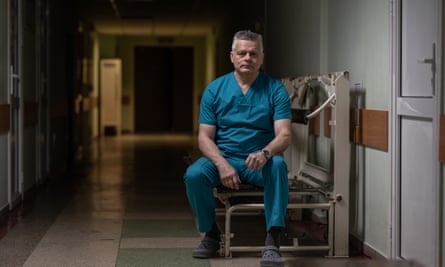
The docs use tiny makeshift oil lamps to offer weak mild when the day is over. Mudryi is reminded of the memoirs of Nikolai Pirogov, the celebrated Russian doctor who carried out subject surgical procedure in the course of the Crimean warfare. Within the house of a month, he has moved from the twenty first century to the nineteenth.
The small workforce is pressured to carry out operations for which they haven’t any expertise. A closely pregnant lady arrives wounded, and so they amputate a leg. She survives, however miscarries.
Many individuals can’t be saved, and the morgue is quickly overflowing. Explosions shatter a lot of the hospital home windows. Mudryi and his household pull their mattresses into the hall, to sleep extra safely.
At some point in late March, the remaining anaesthesiologist, Oleksandr Zhuk, makes an attempt a brief drive exterior the hospital to return a affected person to a different shelter, however on the return journey his automotive is shot up and he’s hit a number of occasions. He makes it again however solely simply, his automotive slamming into the hospital constructing with Zhuk slumped over the wheel and dropping blood quick.
Earlier than dropping consciousness, Zhuk tells the opposite docs what sedation to provide him and whispers his blood group. Mudryi and the surgeons gown the injuries and carry out a transfusion, in semi-darkness, utilizing the blood of somebody within the cellar with an identical group. By some means, Zhuk pulls via.
With each passing day, the preventing will get nearer, and the hospital turns into extra harmful. On the finish of March, they resolve they’ll now not use the generator; it’s as noisy as a tank and Mudryi fears it may draw consideration and result in the hospital being focused.
They inform 10 remaining sufferers who require common kidney dialysis that the machines won’t be switched on once more. Six of the ten wrestle away from bed and depart, on foot, in the direction of the frontline, hoping they could survive the stroll and attain a hospital in Russian-occupied Donetsk in time to obtain dialysis. 4 are too weak to maneuver, and keep behind of their beds to die.
By early April, the world of the hospital is the scene of close-quarter road preventing. For 3 days, Mudryi and the opposite docs are confined to the cellar, whereas 40 sufferers too sick to maneuver are left in beds within the ward.
On 6 April, Russian troopers peer into the basement, asserting they now management the territory and there can be an evacuation. When Mudryi emerges, the hospital buildings have taken a number of hits. He by no means finds out whether or not his sufferers survived or have been burned alive.
By the tip of the preventing, in accordance with one estimate, 82 out of 106 hospitals and different healthcare services in Mariupol have been destroyed or broken.
Azovstal
The Russians are closing in on the centre of Mariupol from all sides. In the midst of April, the military management orders all remaining items of Ukrainian troops defending the town to regroup at Azovstal, the huge metal plant that dominates the Mariupol skyline.
Azovstal, constructed in 1933, is a metropolis inside a metropolis, a sprawling industrial park with dozens of cavernous metal hangars. Underground, there’s a community of basements, a few of which have been fitted out as shelters after the 2014 battle.
The plant serves because the makeshift headquarters of the Azov regiment, a Ukrainian nationwide guard unit that has grown out of a volunteer pressure with hyperlinks to the far proper, which first defended the town in 2014. Azov at the moment are main the defence of Mariupol, insisting they’ve shed their earlier doubtful politics and quickly changing into Ukrainian heroes.
Different items battle their means via to the plant. Sviatoslav Yermonov, a former cop who signed up in March, arrives in a convoy from the port space that comes beneath heavy hearth en route. A couple of third of them are killed on the way in which, he estimates. One other group claims to have made it via by daubing their autos with Russian Z symbols and rushing via enemy traces.

The Azov commanders assign Yermonov and his males a place on the manufacturing unit perimeter. They work in shifts, resting within the basements when again from their defensive positions.
Two of the basements are filled with civilians, plant workers and their households, whom the manufacturing unit director invited to take refuge when the hostilities began, not anticipating that the Ukrainian navy would additionally see the warren of tunnels as the proper place for a final stand in opposition to the Russians.
Situations steadily worsen in all of the basements. Some areas are so dusty and soiled that the troopers discover their garments and uncovered pores and skin are rapidly coated in a thick layer of grime.
Meals is rationed to at least one meal a day; on their transient breaks, Yermonov and his workforce hunt for leftover provisions within the bunkers. There’s loads of black tea, left by the steelworkers, however discovering sugar is a uncommon success and trigger for celebration.

The Russians fly drones to watch actions above floor, then ship in aviation as soon as they clock a possible place. “At first the planes got here in twos, after which in fours. They dropped bombs on the manufacturing unit buildings, on the bunkers,” Yermonov remembers later.
The metal and concrete constructions are surprisingly sturdy, and Yermonov’s hangar stays structurally sound for 2 weeks, regardless of heavy bombardment.


By the tip of April, Azovstal has taken on an epic symbolism for either side. For the Russians, the retreat from Kyiv in late March has left the Kremlin’s preliminary battle plans in tatters, and Mariupol turns into necessary as a tangible achieve, even when they must destroy the town to overcome it. For the Ukrainians, the final stand at Azovstal turns into a David and Goliath story of heroic resistance.
The Russians drop big FAB bombs, which smash via the bottom and attain the basements, the blast influence throwing one wall in opposition to one other and crushing these in between.
Dmytro Kozatsky, a press officer for the Azov regiment, wakes one evening with a begin, considering he has fallen away from bed. He notices the bunker is way colder than normal. When he stands up, he sees that a lot of the wall has gone and he’s standing partially within the open air.
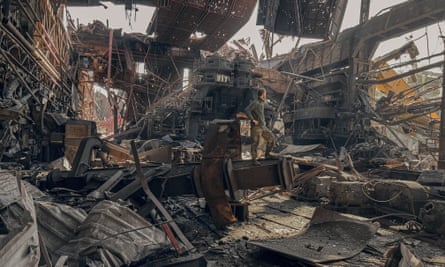
Placing on a jacket and flip-flops, he turns and sees a fellow soldier mendacity on the ground coated in blood, sighing his final breaths. Twelve individuals die within the assault.
As circumstances turn into ever extra insufferable, Ukrainian navy intelligence plans a sequence of daring helicopter missions to deliver provides to the besieged plant. The pilots fly only a few metres from the bottom and hope for the perfect. Not all of them return alive.
The small helicopters can hardly present enough sources for the three,000 individuals nonetheless on the plant, however they do deliver one gamechanging piece of apparatus: Starlink units that permit the Azovstal defenders to beam out images and video every night. Kozatsky’s images of weak troopers laid out with ugly wounds resonate around the globe.
Azovstal is now on the centre of worldwide consideration. The UN secretary normal flies to Moscow to ask Vladimir Putin to open a hall for the civilians on the plant to go away. Wives of the fighters journey to the Vatican to petition the pope.
Lastly, on 1 Might, the United Nations and the Worldwide Committee of the Pink Cross facilitate an settlement between the 2 sides to safe the discharge of the civilians.
An ICRC workforce sleeps in a tent encampment exterior the town and travels into the town to facilitate the discharge. Considered one of them, Mariateresa Cacciapuoti, is aware of Mariupol effectively, having hung out there earlier than the warfare. She is shocked on the degree of destruction she sees on the journey into the town.
With a short ceasefire in place, individuals slowly start to emerge from a gap between slabs of collapsed concrete, the place an airstrike had hit one of many bunkers. “They have been bodily and mentally distressed, they have been so white, that they had not seen the solar for weeks,” Cacciapuoti remembers later.
With the civilians gone, the Russians talk about storming the plant. Amid rumours of a give up, many fighters inside talk about whether or not it could be higher to battle to the very finish, or embark on a suicidal break-out mission to storm Russian traces.
However on 16 Might, after top-secret negotiations between emissaries of Kyiv and Moscow, Ukraine’s normal employees orders the remaining Azovstal fighters to put down their arms.
Over the subsequent 4 days, a complete of two,439 fighters give themselves as much as the Russian forces exterior the plant, with the ICRC overseeing. They’ve months of captivity forward of them. At 4pm on 20 Might, the ultimate group of Azovstal defenders, together with Yermonov, go away the plant.
After greater than 80 days of preventing, the Russians have gained the battle for Mariupol.
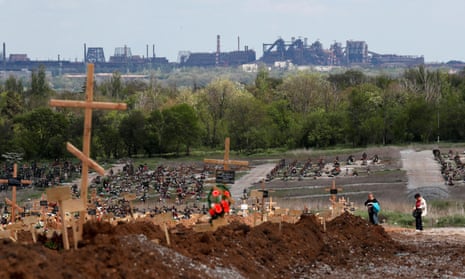
Burials
The Russians rejoice victory within the devastated husk of what was as soon as a vibrant metropolis. Its individuals are ravenous, there is no such thing as a water or electrical energy, and humanitarian organisations warn of a attainable cholera outbreak.
Town is an open cemetery, with hundreds of shallow graves within the courtyards of residence blocks. As rescue groups go door to door, they discover that always the aged or motionless starved to dying of their flats.
Even the propagandists on Russian tv admit the state of affairs is dire. “Residents of destroyed Mariupol are cooking broth from pigeons on bonfires of their courtyard,” the NTV channel tells its viewers in late Might. However the culprits for the devastation are offered as “Ukrainian Nazis”, not the Russian military.
With the return of cellular communications and the tip of preventing, there’s a rush of exercise amongst those that fled to seek out out details about their family members, and to aim dignified burials of the useless the place attainable.
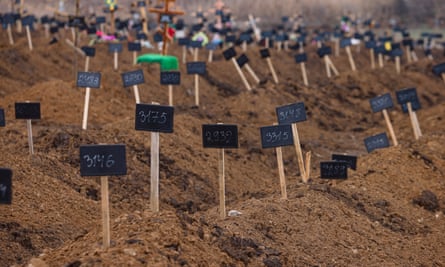
One lady pays $100 to Chechen forces to retrieve the physique of her son from beneath a pile of rubble, the place he has lain for a month. She pays one other $100 to make sure he will get his personal grave on the Starokrymske cemetery, a brief drive exterior city, which is changing into one of many central factors for burying the victims of the siege.
The huge cemetery, overlooking the town skyline and the glimmering Sea of Azov, incorporates fields of ornate monuments, crosses and tombstones from years previous that stretch out into the space.
In June, digging begins on the far finish of the cemetery, with a number of new trenches every holding round 25 coffins. A few of them have names and dates of beginning; most are simply wood indicators marked with numbers.
By December, the variety of makeshift graves is already approaching 4,000, representing a number of months of ugly work for the cemetery workers.
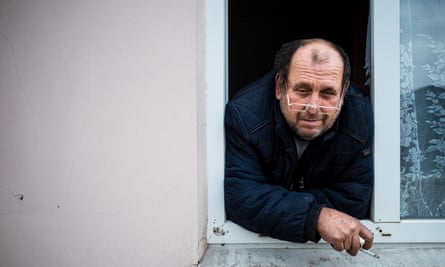
“I don’t know what number of I’ve buried. But it surely’s many. Very many,” says Oleksandr, a soft-spoken gravedigger, his arms leaning on the window body of the cemetery’s administrative constructing.
Oleksandr has labored as a gravedigger for 13 years, however nothing ready him for the previous few months, throughout which burned our bodies and mutilated limbs have been a every day sight.
“Generally we obtained bins with physique components from entire households thrown collectively – mother and father and kids multi function,” he says, shaking his head slowly and pulling on a cigarette.
Overhead, a flock of ravens circles, filling the quiet, ghostly churchyard with the sound of loud, gurgling croaks.
“You see it with your personal eyes, however you don’t know what to assume, or learn how to course of it.”

Reconstruction
The Kremlin appoints St Petersburg, and the far jap metropolis of Khabarovsk, as “patron” cities to supervise the reconstruction of Mariupol, and sends in scores of officers to steer the reconstruction.
In October, Russian outlet the Insider publishes a shiny 32-page doc commissioned by Russia’s development ministry. It’s a plan for the rebirth of Mariupol, full with vibrant slides detailing constructing laws, public transport routes and bike lanes.
In October, the Russian media outlet the Village obtained a shiny 32-page doc commissioned by Russia’s development ministry, containing the fundamentals for a normal plan for Mariupol’s reconstruction. The doc envisages a pleasing metropolis with handy public transport, bike lanes and the fast erasure of all traces of the ugly preventing of the earlier months.
Russian corporations recruit hundreds of central Asian labour migrants to rebuild the town.
Abdulloh, a 24-year-old carpenter from Tajikistan, arrives in Mariupol in mid-December on a protracted bus journey from Moscow, the place he beforehand labored on development websites, along with others from Tajikistan and Kyrgyzstan.
The lads dwell in a half-destroyed faculty dormitory, and work lengthy hours renovating numerous buildings. There are about 300 employees from Tajikistan at Abdulloh’s development website alone.
He’s stunned to listen to that his presence in Mariupol can be thought-about a border violation by Ukrainian authorities. “We have been instructed that this metropolis belongs to Russia and that’s all,” he says. He’s extra involved that the beneficiant wage he was promised has been paid solely partially.
Russian information bulletins are stuffed with tales of joyful residents receiving the keys to flats in newly constructed blocks. However regardless of the intensive rebuilding efforts, it is going to be a really very long time earlier than any semblance of normality involves Mariupol.
Within the previous city, a ramshackle however charming assortment of previous buildings nestled on a slope that descends in the direction of the Sea of Azov, each wall is pockmarked with bullet holes and shrapnel harm, or bigger craters from rockets and grenades. The streets are desolate, save for an occasional passing automotive.
One afternoon in December, a uncommon sight within the eerie quiet: an aged lady carrying a grocery bag and a jug of water. Behind her, three canines observe with playful devotion.
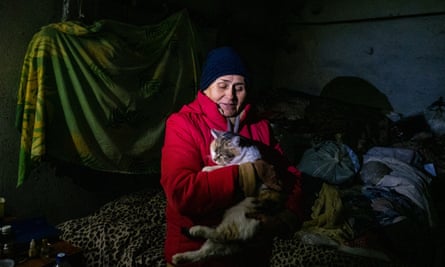
Through the siege, 75-year-old Angela shared the basement of her block with 34 neighbours. Now, they’ve all gone. She alone stayed, and has taken it upon herself to take care of the quite a few stray canines and cats left behind.
Her top-floor residence is damp, windowless and icily chilly. She has coated most of her furnishings with plastic and tarpaulin, preventing a dropping battle in opposition to mould and decay because the roof leaks relentlessly.
The kitchen partitions nonetheless bear the proof of the time a sniper on an opposing rooftop mistook her for a soldier and sprayed bullets via her window, as she stood in her kitchen. Miraculously, she survived with nothing worse than a grazed heel.
With the residence uninhabitable, she nonetheless lives within the concrete basement, and has achieved her finest to make it cosy: there’s a leopard-print blanket on the makeshift mattress and flashing Christmas lights strung over the doorway. The thermometer by the mattress reveals 4C.
“It was a wonderful metropolis, with financial system,” she says, remembering the previous of the place she has referred to as house for many of her seven a long time.
“Perhaps someday it should return to its former glory, however I may not be alive to see it.”

Russification
Together with reconstruction comes Russification. Symbols of Ukrainian rule are swiftly erased, beginning with the massive signal welcoming guests to Mariupol, repainted within the crimson, white and blue of the Russian flag.
Streets and squares have their Soviet names restored. Omnipresent billboards and posters with the image “Z” painting the Russian occupiers as liberators.
For individuals who have working televisions, the programming is switched to Russian; web site visitors can also be routed via Russian servers and entry to many Ukrainian websites blocked.
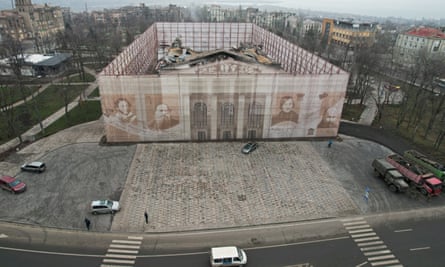
The thought is to repeat the expertise of Grozny, the capital of Chechnya. Bombed to ruins by Putin’s troops on the very starting of his reign over Russia, it was later rebuilt as a glittering metropolis utilizing intensive subsidies from Moscow. Its foremost avenue was renamed in Putin’s honour and reminiscences of the lengthy historical past of Chechen resistance in opposition to Russia have been suppressed.
In Mariupol, too, the horrors of the previous – each latest and extra distant – are to be forgotten. Russian directors destroy Mariupol’s monument to the Holodomor, the synthetic famine visited on Ukraine by Stalin’s regime within the Nineteen Thirties.
In one other a part of the town, they erect a monument to Alexander Nevsky, a Thirteenth-century prince. The governor of St Petersburg, in Mariupol to open the monument, claims Nevsky defended medieval Rus in opposition to “enemies who got here from the identical international locations Russia is preventing at the moment”.
Academics within the metropolis are pressured to signal a doc certifying their willingness to change to educating the Russian college curriculum. It contains a Kremlin-approved model of historical past which casts doubt on Ukraine’s sovereignty and historical past as an impartial nation since 1991. Some lecturers are despatched to summer season faculties in Rostov or Moscow, the place they bear a retraining programme. Ukrainian schooling “have to be corrected”, says Russia’s schooling minister Sergey Kravtsov.
Administrative places of work open throughout the town, the place native individuals can obtain passports that flip them in a single day from Ukrainians to Russians, within the eyes of the Kremlin at the least. 1000’s queue to obtain them; in spite of everything, a Russian passport is required to obtain a pension or register a enterprise.
On 4 November, Russia’s nationwide unity day, Putin describes Mariupol as an “historic Russian metropolis”. As proof, the Russian president cites the “well-known” incontrovertible fact that Peter the Nice based his first naval flotilla there within the early 18th century. The declare is completely fabricated.
“Putin’s grasp of historical past is totally ludicrous,” says Vadym Korobka, a historical past professor at Mariupol State College, with a bittersweet chuckle.

Native assist
There has all the time been a pro-Russian contingent in Mariupol, although after 2014 it dwindled as funding from Kyiv improved life for a lot of within the metropolis. However some locals are nonetheless receptive to Russian messaging and blame the latest months of distress on Ukraine.
Korobka, the historian, remembers sheltering within the basement of his residence block in the course of the siege and listening to a few of his neighbours name the Ukrainian defenders of Mariupol “Nazis”, and demand that Russian forces would by no means shell a residential space, at the same time as they have been doing so at that very second.
Now the Russians are in management, they co-opt native supporters and opportunists to assist unfold this narrative. Amongst them is Andriy Kior, a 52-year-old former spokesperson for Mariupol metropolis council, who launches the Voice of Mariupol, a brand new pro-Russian newspaper.
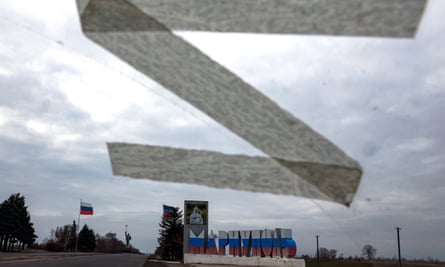
Earlier than the invasion, in an interview at his residence, Kior spoke of his love for Ukraine’s pure magnificence and described Russia as Ukraine’s “foremost opponent”.
The change of guard within the metropolis prompts a outstanding turnaround in his views.
“Persons are seeing the massive alternatives that Russia is giving them,” he claims in a phone interview a yr later, with the zeal of a convert. “Town is being restored at an unbelievable tempo, all because of Russia.”
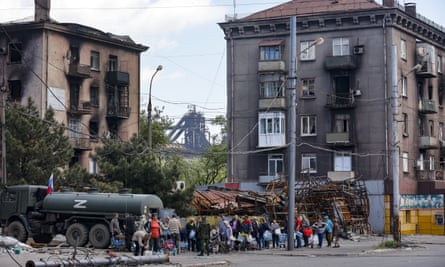
Darya, a 24-year-old scholar who left Mariupol in the summertime, returns to the town in January, to take care of relations and to be near the grave of her boyfriend. She is amazed to seek out many individuals stuffed with reward for Moscow.
“They’re grateful for the assistance they obtain, forgetting or ignoring that Russia was the one who took all of it away from us. It blows my thoughts,” she says, mournfully.

Darya quickly realises she doesn’t have the emotional vitality for these conversations. She learns learn how to discern an individual’s political beliefs in a number of moments. “It’s the means they discuss, take a look at you, little issues give it away. You be taught to solely voice your opinions with these you already know you may belief. In any other case, you retain your ideas to your self.”
As she walks among the many ruins, in all places she appears to be like Darya sees the Russian propaganda posters, the paint-daubed Z symbols and the flags of the so-called Donetsk Folks’s Republic.
On occasion, she sees a special form of image: “Glory to the Ukrainian Military” splashed in paint on a wall, or a poster asserting that “Mariupol is Ukraine”. Generally, individuals have merely painted the letter ï, which exists in Ukrainian however not in Russian. It’s a shorthand mode of resistance, and a glimmer of hope for these within the metropolis who lengthy for Kyiv’s return.
“I stroll previous and provides it a smile. There isn’t a lot else we will do,” she says.

Mariupol in exile
An estimated 350,000 individuals have left Mariupol. Some try to start out their lives anew in Russia, others are trying to rebuild elsewhere in Ukraine. Many have turn into refugees in different international locations, working onerous to place the reminiscences of the horrors they witnessed and the losses they sustained behind them.
Ukrainian authorities, pointing to the gorgeous recapture of Kherson in November, hope that earlier than too lengthy, they may equally be capable of liberate Mariupol.
For now, the town’s Ukrainian administration works in exile, from Kyiv, led by the mayor, Boychenko. Throughout an interview, he will get visibly emotional when requested in regards to the anger many really feel about his resolution to go away the town quickly after the invasion. It was solely from the security of afar, he claims, that he may coordinate efforts to rearrange evacuations.
Mariupol State College has quickly relocated to Kyiv too, renovating a constructing there and with plans to start out in-person tuition in September. Its rector, Mykola Trofymenko, claims solely 10% of his educating employees stayed in Mariupol and agreed to work for the duplicate model of the college, arrange by the Russians.
“They may all have inquiries to reply later,” he says, darkly.
Ukrainian police items are monitoring information and social media posts from Mariupol, making an inventory of these cooperating with the Russians. Quickly, they hope, Ukrainian authorities can be again in Mariupol, and maintain these individuals accountable as traitors.
However in Mariupol, as in different territories occupied by Russia, it is a troublesome and emotional matter on which there are numerous disagreements. The place is the road between cooperation to outlive and collaboration? With each passing month of Russian rule, that potential future course of turns into extra fraught with difficulties.
Amongst those that left Mariupol, many don’t plan to return until Ukraine takes the town again; others have misplaced their houses and livelihoods and don’t see any sense in returning to the town no matter occurs.
In Warsaw, Kateryna Shukh, a Mariupol-born psychologist who managed to go away the town on the very begin of the warfare, works with latest arrivals from Mariupol. In group remedy classes, the ladies draw their emotions or work collectively to make various things. They practise respiratory methods. Generally everybody cries. It’s signal when that occurs, says Shukh, as a result of it means individuals really feel protected sufficient to launch their emotions.

She tells them that what they lived via will stick with them, and possibly change them for ever, however that they’ll work on the way it will affect them. “Folks want time to adapt. It’s a double course of, to cope with what occurred and to review learn how to dwell now,” she says.
Particularly for the older refugees, the truth that they might by no means be capable of return house may cause a state of psychological paralysis and a refusal to simply accept actuality. However Shukh’s private expertise provides her recommendation extra credibility. “I used to be born on this metropolis and lived my entire life there. I misplaced every part. So these girls, I perceive their emotions from the within,” she says.
Shukh advises her shoppers to not subscribe to Telegram channels about Mariupol; to not scroll via footage from the occupied metropolis. It brings feelings of anger and helplessness, neither of that are helpful. However she admits that she isn’t all the time capable of observe her personal recommendation. The pull of house is an excessive amount of, and she or he finds herself drawn to the photographs and movies.
Though the movies on the Telegram channels are shot in Mariupol, they don’t seem to be the place Shukh as soon as referred to as house. Even when Ukraine takes again Mariupol within the close to future, the ache and trauma of the final yr will go away an indelible mark on the town and its individuals.
“You perceive that the place you spent your entire life won’t ever be there once more,” she says. “It’s gone.”
Trending
-
Bank and Cryptocurrency11 months ago
Cheap Car Insurance Rates Guide to Understanding Your Options, Laws, and Discounts
-
Bank and Cryptocurrency11 months ago
Why Do We Need an Insurance for Our Vehicle?
-

 entertainement5 months ago
entertainement5 months agoHOUSE OF FUN DAILY GIFTS
-
WORD NEWS12 months ago
Swan wrangling and ‘steamy trysts’: the weird lives and jobs of the king’s entourage | Monarchy
